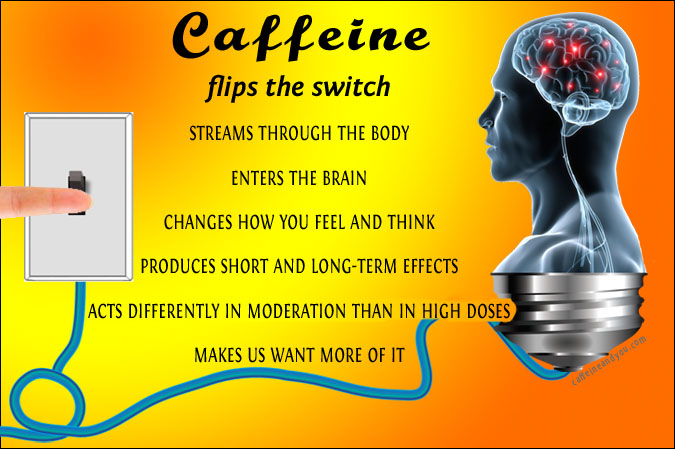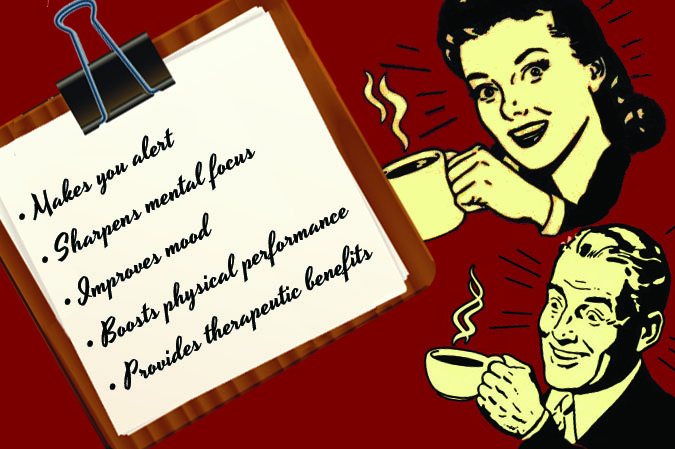Stay Alert caffeinated gum was initially a joint project by Walter Reed Army researchers and Wrigley’s Gum. After its success with American troops, Israeli’s elite pilots and special operation forces added it to their supply arsenal in 2011. The pilots were skeptical at first, but after getting past the taste, they now carry caffeinated gum on all missions lasting more than 48 hours. Full article: Caffeinated gum keeps Israeli pilots, commandos alert
Archives for 2013
Caffeine Basics: Intro and Contents
Caffeine Basics: A User’s Manual
* Caffeine came without instructions. THIS is the missing manual.*
Welcome to my free online book about the basics of caffeine – including coffee, tea, chocolate, soda energy drinks and more. Think of this as your “user’s manual” for caffeine. It’s a complete book and separate from my blog posts. You can move through the chapters sequentially: arrows at the bottom of each Caffeine Basics Post lead you to the next entry in the book. Or you can jump around using the Table of Contents below. Blog readers may also use the site’s SEARCH button to find info in the book’s chapters and in the blog posts. NOTE: New chapters are uploaded as soon as they are completed.
Table of Contents:
The complete book includes 12 chapters in all. Chapters will be added here as they are uploaded.
1. How Caffeine Works: Flipping the Switch
Most of us treat caffeine like electricity: We don’t care to know how it works; we just flip the switch and the power turns on.
Here’s what happens when you flip the caffeine switch…
- Caffeine streams throughout the body
- Caffeine enters the brain
- Caffeine changes how you feel and think
- Caffeine produces short and long-term effects
- Caffeine acts differently in moderation than in high doses
- Caffeine makes us want more of it
A Quick Inventory of Caffeine’s Effects
Nobody forces us to ingest caffeine. It’s not necessary. We choose to do so.
In studies where participants didn’t know they were ingesting caffeine, they opted for caffeinated beverages over non-caffeinated ones. This suggests that something in caffeine makes our brains love it, or at least want it, whether we know it or not.
So even without understanding how caffeine works, it’s easy to understand our attraction to caffeine. Here’s a rundown of the bells and whistles that come with a low to moderate dose of caffeine (100-200 mg for most people, and no more than 300 mg):
Makes you alert: Caffeine quickens reaction times and improves alertness. It reduces fatigue.
Sharpens mental focus: Attention spans last longer. Under caffeine, concentration improves. Memory may or may not improve, but caffeine appears to protect against memory loss, especially when you’re under stress. (Benefits to memory are inconclusive.)
Improves mood: People report increased well-being, happiness, and sociability. They feel energized and less depressed.
Boosts physical performance: Athletes experience improved speed, endurance, and reaction time. Caffeine helps the body burn fat instead of carbohydrate, blunts pain, and can suppress appetite.
Provides therapeutic benefits: Caffeine relieves pain. It’s also a powerful antioxidant. It can protect certain cells from long-term damage. Current research suggests caffeine may also reduce cognitive decline associated with aging, dementia, and Alzheimer’s. It also appears to prevent gallstones, and is used in treatment for Parkinson’s disease, liver disease, and colorectal cancer. It opens up bronchial passages, and helps asthmatics breathe easier. Caffeine leads to increased stimulation of your heart.
At the same time, caffeine can be fickle and flighty in its actions. Caffeine can benefit the heart by dilating coronary arteries and speeding up oxygen delivery. In the brain, caffeine has the opposite effect; it constricts blood vessels, reducing pressure and blood flow to the brain, and relieving headaches. In the lungs, caffeine relaxes bronchial tubes, making breathing easier.
What Does Caffeine Do in Your Brain?
 Coffee, tea, chocolate and cola drinks are the most traditional sources of caffeine. Energy drinks and energy shots are the latest methods to boost your body with caffeine. So what happens when you perk up with one of these substances?
Coffee, tea, chocolate and cola drinks are the most traditional sources of caffeine. Energy drinks and energy shots are the latest methods to boost your body with caffeine. So what happens when you perk up with one of these substances?
Throughout the day, brain cells create a neurotransmitter known as adenosine. Adenosine, often shortened to “ado,” is the first key to understanding how caffeine works. It’s what makes us sleepy and triggers hibernation in animals.
Adenosine gradually builds up throughout the day, giving us energy, until it reaches a saturation level. To stop its own activity, and keep us from being endlessly active, ado bonds to specific receptors – and this leads to deep, restorative sleep.
That is, of course, unless caffeine invades the brain.
Caffeine, The Great Imposter
To adenosine receptors, caffeine looks and acts remarkably like the real adenosine, so they say, “Okay, let’s bind to this guy” (not realizing he’s really caffeine). The binding of adenosine normally slows you down, but when it’s bouncing around in your brain, you’re energized and your nerve cells are speeded up. Along comes caffeine: your adenosine cells should be heading to bed, but caffeine has blocked the bedroom door.
So adenosine continues to party, and you feel alert. Meanwhile, caffeine works the room, chatting up the central nervous system with all sorts of stimulating conversation. Caffeine’s mere presence literally punches the brain’s happy button; it coaxes the brain’s pleasure center to release the ever-popular dopamine, a neurotransmitter that creates happy feelings of well being and good mood.
Neurotransmitters Join the Party
Once your neural pathways start firing on all cylinders, the “fight or flight” mode kicks in; adrenaline spikes, giving you that get-up-and-go boost. When adrenaline (also known as the hormone epinephrine) is released, the body goes into a heightened state of alert. Everything starts speeding up. Your blood pressure and heart rate rise, and your blood sugar spikes to release even more energy. You feel alert and your appetite is suppressed.
But as the caffeine in your brain subsides, so do these effects. Dopamine and adrenaline levels relax, and the real adenosine pushes past the withering caffeine to bond to its receptors.
Over time, everything returns to normal. Nerve cell activity slows down. But the brain remembers just how good that caffeine rush feels. And some experts say this feel-good state is what really leads to a caffeine habit.
But this is just a short story. Caffeine’s complete effects on the brain and body are far more intricate and subtle, as we’ll see later.
- « Previous Page
- 1
- …
- 8
- 9
- 10
- 11
- 12
- …
- 19
- Next Page »




